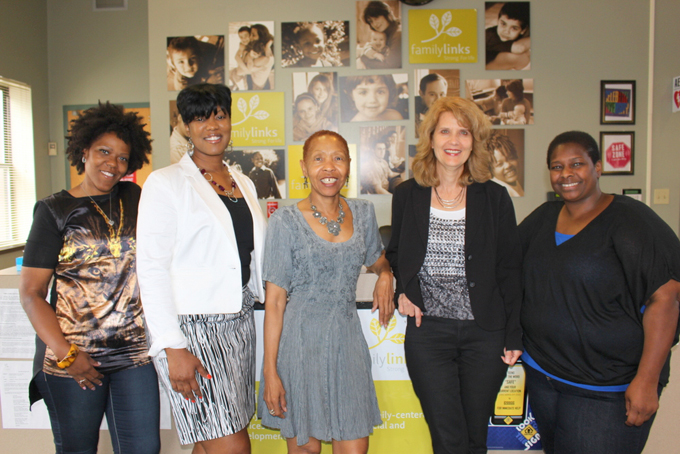
Keeping with its mission to treat individuals wholistically—in mind, body and spirit—during their recovery from substance abuse, Familylinks Inc. has recently undergone several changes to ensure that they are more effectively meeting the needs of their clients.
In April, after several staffing changes, its treatment providers, who offer residential as well as outpatient treatment services, changed the name of their outpatient facility from the Community Support Center to the Recovery Support Center, to reflect their main focus.
“The overall philosophy of Familylinks in all of our services goes from most restrictive to least restrictive of care based upon the needs of our clients,” said Fred Massey, CEO of Familylinks. “We provide individuals an evolution of continuing recovery services as they go through their growth and treatment.”
Maisha Howze, Familylinks senior program manager of AOD Services, said “recovery” is a word that has the power to change lives and gives people addicted to alcohol and other drugs the space to acknowledge the past, heal and grow into a new path.
“Recovery is an active process that is, according to the Office of Mental Health and Substance Abuse, facilitated by relationships and environment, and choices and opportunities that promote reaching their full potential as individuals and community members,” she said. “We wanted to make sure that people knew healing of the whole person was our focus and the name of our program now reflects this ideal.”
While its resources through their Family Treatment Center, a six-month residential program, are only available to women and their children up to age 12, the Recovery Support Center is available to men, women and adolescents facing addiction.
According to Howze, the Center, located on Shady Avenue in Shadyside, currently serves 45 individuals, with 52 percent of them being African-Americans. What makes this program unique, she said, is that it offers case management services; onsite childcare that incorporates developmental activities for children of clients participating in therapies, an onsite psychiatrist and several levels of care: outpatient, intensive outpatient and partial hospitalization.
Handling addiction is tough enough, but when additional pressures such as issues of employment, transportation, insurance, etc. are added, it can often be too much to handle. Howze said the center’s staff supports clients with developing life skills, functions as advocates, and assists in various application processes and provides a linkage to other needed support services.
“If they’re coming here for treatment and say they just got a notice that their lights are going to be shut off, they’re not focusing on that group. So we work to help eliminate barriers that may limit a person’s ability to enter and remain in treatment services. The goal of the Recovery Support Center is to serve the whole person by providing comprehensive support to the participants.”
Recently, in June, the Recovery Support Center, introduced Suboxone to its treatment program. Suboxone is a medication that contains buprenorphine and naloxone and is approved for the treatment of opiate dependence.
“If you understand addiction, you understand that everyone’s past is different-how they started to use, how they maintained their addiction and the way they’re going to maintain a life of recovery is different,” Howze said. “Years past, people’s mindset was either behavior modification or you had to go through NA or AA and that’s how you just stopped using. Well, people started seeing, especially with opioid dependents, the attempt to stop is so painful for some that they’d rather just go back to using. We figure just having them stop may not help them and we needed to be of assistance.”
The approval for Suboxone, Massey said, took approximately a year and their commitment to the process is just another example of Familylinks’ dedication to providing the services their clients need “based upon the most effective information that is out there.”
Howze said the introduction of the regulated drug was also a response to a call being made by Allegheny County officials; they were asking treatment providers to help during a time when there had been a high number of drug overdoses taking place in the county.
With the Recovery Support Center is located in Shadyside, Howze and Massey agree that its location, which is near East Liberty and Garfield, is highly effective for reaching those in need, especially within the Black community.
“I’m not saying that most Black people don’t have cars, but I do recognize we have a lot more limitations than others, so it is a convenient location,” said Howze.
Massey said, “We service everyone. Our philosophy is we need to meet people where they’re at. So I believe the location is good because it has access to the busway, we have a parking lot and it’s a good environment.”
He also pointed out that a good environment is critical to one’s recovery. In an addicts life there are certain triggers that cause the use of drugs and alcohol, and once they return to their previous environment, they have to be aware of those triggers and how to overlook them.
“We want to make sure that while they’re attempting to recover, that they are able to (do so) without having to be faced with some of the same triggers that caused them to need treatment in the first place,” said Massey.
As for the Recovery Support Center’s future, Howze said she sees it growing in terms of quantity as well as quality.
“You can increase your numbers by 20 to 30 percent but still provide quality care so we don’t face the issue of a revolving door,” said Howze. “If you provide them with the support they need and teach them how to be self-sufficient and maintain a healthy, productive life, then you won’t see them coming back.”
(For more information on Familylinks and its services, visit www.familylinks.org.)